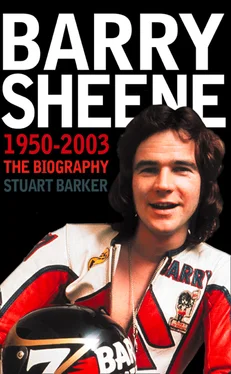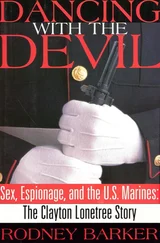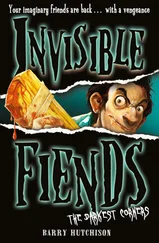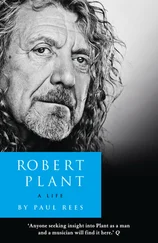The potential dangers of mechanical problems increased considerably when the GP circus travelled to the unforgiving public-roads course that was the Isle of Man TT, Britain’s round of the World Championship at the time, and a place Sheene learned very quickly to hate. The TT had started in 1907, and Barry had enjoyed the meet as a young spectator and paddock helper. Riding it, though, was a different matter altogether. The course is unique in that it is 37.74 miles long and lined with walls, houses, lamp-posts and every other hazard you’d expect to find on normal rural and urban public roads. Grand Prix circuits in the seventies were still nowhere near as safe as they are now, but they were a lot safer than the TT course, if only because they were shorter and easier to learn. In 1971, Sheene decided to race on the Isle of Man to try to score some valuable points for his world title campaign. It was a move that would define Sheene’s views on the event and make him many enemies among traditionalists who continued to support the TT despite its perils.
Those traditionalists have always scoffed at the fact that Sheene crashed out of his first race there, but he’d actually been on the leaderboard before the incident. He posted the third fastest time in practice on his 125cc Suzuki and was leading the race at one point on the opening lap until he hit thick fog and eased off the throttle. When his overworked clutch bit too hard just after the start of the second lap, Sheene was tossed from his bike at the slow, first-gear Quarterbridge corner and his race was run – much to Barry’s relief, as he’d been hating every minute of it. But that wasn’t quite the end of Sheene’s TT career: he still had an outing in the production event on a 250cc Suzuki. Again, he posted respectable times in practice, but after suffering a massive tankslapper (or ‘speed wobble’, as it was more quaintly referred to at the time), during which the front end of the bike shakes viciously from side to side, parts of his machine started to work themselves loose and Barry pulled in after just one lap. He never raced on the Island again.
A rider’s decision not to race at the TT would never normally cause any kind of commotion; it is a free world after all, and no one forces racers to take part in the TT. But Sheene wasn’t content just to stay away from the island. Over the next few years he embarked upon a sustained one-man attack on the event and played a major role in the TT eventually being stripped of its World Championship status – a crime for which some have never forgiven him.
Racing fanatics fall into one of two camps over the whole Sheene/TT issue: if you love the TT, you hate Barry Sheene, and if you hate the TT, you tend to agree with Sheene’s actions. Barry’s major bone of contention was that riders shouldn’t be asked to race on such a dangerous track just to gain championship points. He never wanted the TT to be banned as such, he just wanted riders to have the choice of whether or not to race there, his thinking being that when valuable points are at stake riders may be tempted to push their luck to earn a few. TT supporters claimed that the throttle works both ways and riders can take things as easy as they want to, thereby reducing the dangers. Many supporters of the event have said that Barry was just too scared to race there, or that he couldn’t be bothered to spend the usual three years to learn the course well enough to win on it. The second argument falls down when you consider that Sheene was leading his first race there before he crashed, and Barry himself responded to the first accusation: ‘The Mountain [TT] circuit did not frighten me in any way. No circuit frightens me. I just couldn’t see the sense of riding around in the pissing rain completely on your own against a clock. It wasn’t racing to my mind.’
Don Morley, a professional photographer and journalist since 1955 and one of the most respected photographers in the business, has a different take on Sheene’s aversion to the TT. Morley has probably taken more pictures of Sheene than anyone else and was always privy to the gossip and chatter in the paddocks of the racing world. ‘Barry made a bit of a name for himself slagging off the TT, but it was more to do with money than the dangers of the place,’ he said. ‘A normal Grand Prix lasted three days whereas the TT was a two-week event and it cost the riders an awful lot of money to compete there. There was very little prize money and it was awkward for the GP riders to get to the Isle of Man from the Continent. They had to drive to a port, get a ferry to England, drive again and then get another ferry to the Isle of Man which was a lot more difficult than just driving from the Spanish GP to the French GP, for example. Then they had to pay for a hotel for two weeks instead of just three days as well as all the other expenses. It was good for the organizers, but not the riders. This was in the days before lots of long-haul Grands Prix, and it just didn’t make financial sense.’
In 1972 Giacomo Agostini, who won 10 TTs and 15 World Championship titles, joined Barry’s protest after his close friend Gilberto Parlotti was killed on his TT debut. Ago said he would never race there again, and he kept his word. He was joined by Phil Read, though five years later he changed his mind and did race there again. The event was finally struck from the Grand Prix calendar after 1976, much to Sheene’s approval.
Sheene’s name was dragged up in the press for more than a decade whenever there were calls for the TT to be banned outright, and to this day there is still a lot of resentment among TT fans towards him. But it’s worth remembering that while Sheene hated riding at the TT (‘Why bother when it’s so much easier just to shoot yourself and get it all over with?’), it didn’t stop him racing on other pure road cricuits, most notably Oliver’s Mount in Scarborough, a treacherous, narrow and bumpy parkland circuit. And many Grand Prix circuits such as Spa-Francorchamps in Belgium and Imatra in Finland were armco-lined pure road circuits too.
Certainly Sheene’s criticism of the TT circuit ran somewhat in contradiction to his view on these other dangerous circuits, a fact he attempted to explain in Leader of the Pack. In justifying his decision to continue racing at the Oliver’s Mount track, he said, ‘As with any other circuit, if there are sections which you can’t tackle with confidence, it’s up to you to ride through those sections at the pace best suited to you. You can make up for lost time in other stretches, where there is less likelihood of hurting yourself.’ Surely that same theory could apply to the TT circuit as well as any other?
Mick Grant, himself a seven-times TT winner and a staunch supporter of the event, was one of Barry’s fiercest rivals in the seventies. He testified to Sheene’s abilities on road circuits despite his aversion to the TT. ‘Although Barry knocked the TT, we never actually spoke about it together. My regret with Barry was that he didn’t continue with the TT. Certainly the way he rode on pure road circuits like Scarborough and Imatra, there was no way that he couldn’t have done the TT. I mean, bloomin’ hell, Scarborough requires all the road racing skills you’d ever need, and he could do it. He certainly wasn’t slow round there.’
Still, from 1971 the Isle of Man was out of his hair for good and Barry was free to concentrate on the next round of the World Championship, to which he travelled in a bit more style – in his newly purchased caravan. To the modern GP follower this will sound more like a club racer’s accommodation, but in 1971 it was the last word in luxury. For some, this was the start of Sheene the poser. Upstart relative newcomers to the GP scene were expected to sleep on the floors of their oily vans rather than tow a caravan around like a wealthy American tourist, but to Sheene it just made practical sense. With a more comfortable bed and an area for cooking some decent food, he would be in better shape for the racing. And if it added to his glamour-boy image and helped to improve standards in the paddock, then so much the better. One thing Sheene certainly wasn’t slow to notice was that having a caravan greatly increased his pulling power with the ladies, and for Barry that fact alone was worth the extra expenditure.
Читать дальше












